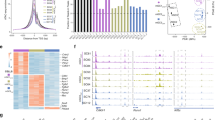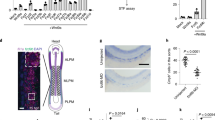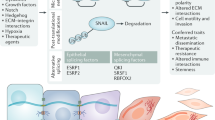Abstract
Stem cells share several characteristics of cancer cells including loss of contact inhibition and immortality. Therefore, stem cells represent an excellent model system in which to define the molecular mechanisms underlying cancer development and progression. Several signal transduction pathways including leukemia inhibitory factor, Wnt and FGF have been demonstrated to function in stem cell self-renewal and differentiation. However, more recently bone morphogenetic proteins (BMPs) have emerged as key regulators of stem cell fate commitment. Intriguingly, BMPs have disparate roles in regulating the biology of embryonic stem (ES) cells compared with neural crest stem cells (NCSCs). Furthermore, although BMPs block neural differentiation of ES cells from both mouse and human, they contribute to self-renewal specifically in mouse ES cells. These observations strongly suggest that combinations of extracellular factors regulate stem cells, and that crosstalk between intracellular signaling pathways precisely defines stem cell fate commitment. In this review, we focus on the role of BMP signaling in mouse and human ES cells compared with NCSCs. We then discuss how the molecular effectors of BMP signaling may contribute to cancer, and thus represent potential targets for therapeutic intervention.
This is a preview of subscription content, access via your institution
Access options
Subscribe to this journal
Receive 50 print issues and online access
$259.00 per year
only $5.18 per issue
Buy this article
- Purchase on Springer Link
- Instant access to full article PDF
Prices may be subject to local taxes which are calculated during checkout



Similar content being viewed by others
References
Alvarez Martinez CE, Binato R, Gonzalez S, Pereira M, Robert B and Abdelhay E . (2002). Biochem. Biophys. Res. Commun., 291, 655–662.
Amit M, Shariki C, Margulets V and Itskovitz-Eldor J . (2004). Biol. Reprod., 70, 837–845.
Anderson DJ, Groves A, Lo L, Ma Q, Rao M, Shah NM and Sommer L . (1997). Cold Spring Harb. Symp. Quant. Biol., 62, 493–504.
Anderson DJ . (2000). Philos. Trans. R. Soc. Lond. Ser. B, 355, 953–964.
Attisano L and Wrana JL . (2002). Science, 296, 1646–1647.
Benchabane H and Wrana JL . (2003). Mol. Cell. Biol., 23, 6646–6661.
Brugger SM, Merrill AE, Torres-Vazquez J, Wu N, Ting MC, Cho JY, Dobias SL, Yi SE, Lyons K, Bell JR, Arora K, Warrior R and Maxson R . (2004). Development, 131, 5153–5165.
Chai Y, Ito Y and Han J . (2003). Crit. Rev. Oral Biol. Med., 14, 78–88.
Chambers I and Smith A . (2004). Oncogene, 23, 7150–7160.
Chambers I, Colby D, Robertson M, Nichols J, Lee S, Tweedie S and Smith A . (2003). Cell, 113, 643–655.
Donovan PJ, De Miguel MP, Hirano MP, Parsons MS and Lincoln AJ . (2001). Int. J. Dev. Biol., 45, 523–531.
Draper JS and Fox V . (2003). Arch. Med. Res., 34, 558–564.
Ernst M, Oates A and Dunn AR . (1996). J. Biol. Chem., 271, 30136–30143.
Gammill LS and Bronner-Fraser M . (2002). Development, 129, 5731–5741.
Hari L, Brault V, Kleber M, Lee HY, Ille F, Leimeroth R, Paratore C, Suter U, Kemler R and Sommer L . (2002). J. Cell Biol., 159, 867–880.
Hata A, Seoane J, Lagna G, Montalvo E, Hemmati-Brivanlou A and Massague J . (2000). Cell, 100, 229–240.
He XC, Zhang J, Tong WG, Tawfik O, Ross J, Scoville DH, Tian Q, Zeng X, He X, Wiedemann LM, Mishina Y and Li L . (2004). Nat. Genet., 36, 1117–1121.
Henningfeld KA, Rastegar S, Adler G and Knochel W . (2000). J. Biol. Chem., 275, 21827–21835.
Hollnagel A, Oehlmann V, Heymer J, Ruther U and Nordheim A . (1999). J. Biol. Chem., 274, 19838–19845.
Howe JR, Bair JL, Sayed MG, Anderson ME, Mitros FA, Petersen GM, Velculescu VE, Traverso G and Vogelstein B . (2001). Nat. Genet., 28, 184–187.
Hussein SM, Duff EK and Sirard C . (2003). J. Biol. Chem., 278, 48805–48814.
Joseph NM, Mukouyama YS, Mosher JT, Jaegle M, Crone SA, Dormand EL, Lee KF, Meijer D, Anderson DJ and Morrison SJ . (2004). Development, 131, 5599–5612.
Karaulanov E, Knochel W and Niehrs C . (2004). EMBO J., 23, 844–856.
Kleber M, Lee HY, Wurdak H, Buchstaller J, Riccomagno MM, Ittner LM, Suter U, Epstein DJ and Sommer L . (2005). J. Cell Biol., 169, 309–320.
Korchynskyi O and ten Dijke P . (2002). J. Biol. Chem., 277, 4883–4891.
Labbe E, Letamendia A and Attisano L . (2000). Proc. Natl. Acad. Sci. USA, 97, 8358–8363.
Le Douarin NM and Dupin E . (2003). Curr. Opin. Genet. Dev., 13, 529–536.
Lee HY, Kleber M, Hari L, Brault V, Suter U, Taketo MM, Kemler R and Sommer L . (2004). Science, 303, 1020–1023.
Lo KC, Chuang WW and Lamb DJ . (2003). J. Urol., 170, 2453–2458.
Massague J and Wotton D . (2000). EMBO J., 19, 1745–1754.
Matsuda T, Nakamura T, Nakao K, Arai T, Katsuki M, Heike T and Yokota T . (1999). EMBO J., 18, 4261–4269.
Mitsui K, Tokuzawa Y, Itoh H, Segawa K, Murakami M, Takahashi K, Maruyama M, Maeda M and Yamanaka S . (2003). Cell, 113, 631–642.
Miyazawa K, Shinozaki M, Hara T, Furuya T and Miyazono K . (2002). Genes Cells, 7, 1191–1204.
Morrison SJ, White PM, Zock C and Anderson DJ . (1999). Cell, 96, 737–749.
Munoz-Sanjuan I and Brivanlou AH . (2002). Nat. Rev. Neurosci., 3, 271–280.
Nakashima K, Yanagisawa M, Arakawa H, Kimura N, Hisatsune T, Kawabata M, Miyazono K and Taga T . (1999). Science, 284, 479–482.
Pera MF and Herszfeld D . (1998). Reprod. Fertil. Dev., 10, 551–555.
Pera MF and Trounson AO . (2004). Development, 131, 5515–5525.
Pera MF, Andrade J, Houssami S, Reubinoff B, Trounson A, Stanley EG, Ward-van Oostwaard D and Mummery C . (2004). J. Cell Sci., 117, 1269–1280.
Pomp O, Brokhman I, Ben-Dor I, Reubinoff BE and Goldstein RS . (2005). Stem Cells, (in press).
Qi X, Li TG, Hao J, Hu J, Wang J, Simmons H, Miura S, Mishina Y and Zhao GQ . (2004). Proc. Natl. Acad. Sci. USA, 101, 6027–6032.
Sato N, Meijer L, Skaltsounis L, Greengard P and Brivanlou AH . (2004). Nat. Med., 10, 55–63.
Sato N, Sanjuan IM, Heke M, Uchida M, Naef F and Brivanlou AH . (2003). Dev. Biol., 260, 404–413.
Schmidt C and Patel K . (2005). Anat. Embryol. (Berlin), (in press).
Sell S . (2004). Crit. Rev. Oncol. Hematol., 51, 1–28.
Shah NM, Groves AK and Anderson DJ . (1996). Cell, 85, 331–343.
Shibamoto S, Winer J, Williams M and Polakis P . (2004). Exp. Cell. Res., 292, 11–20.
Tanaka M, Hadjantonakis AK and Nagy A . (2001). Methods Mol. Biol., 158, 135–154.
Tiedemann H, Asashima M, Grunz H and Knochel W . (2001). Dev. Growth Differ., 43, 469–502.
Wang G, Zhang H, Zhao Y, Li J, Cai J, Wang P, Meng S, Feng J, Miao C, Ding M, Li D and Deng H . (2005). Biochem. Biophys. Res. Commun., 330, 934–942.
Wobus AM and Boheler KR . (2005). Physiol. Rev., 85, 635–678.
Wozney JM, Rosen V, Celeste AJ, Mitsock LM, Whitters MJ, Kriz RW, Hewick RM and Wang EA . (1988). Science, 242, 1528–1534.
Xu RH, Chen X, Li DS, Li R, Addicks GC, Glennon C, Zwaka TP and Thomson JA . (2002). Nat. Biotechnol., 20, 1261–1264.
Xu RH, Peck RM, Li DS, Feng X, Ludwig T and Thomson JA . (2005). Nat. Methods, 2, 185–190.
Ying QL, Nichols J, Chambers I and Smith A . (2003). Cell, 115, 281–292.
Zhang W, Yatskievych TA, Cao X and Antin PB . (2002). J. Biol. Chem., 277, 45435–45441.
Author information
Authors and Affiliations
Corresponding author
Rights and permissions
About this article
Cite this article
Varga, A., Wrana, J. The disparate role of BMP in stem cell biology. Oncogene 24, 5713–5721 (2005). https://doi.org/10.1038/sj.onc.1208919
Published:
Issue Date:
DOI: https://doi.org/10.1038/sj.onc.1208919
Keywords
This article is cited by
-
Regulated interaction of ID2 with the anaphase-promoting complex links progression through mitosis with reactivation of cell-type-specific transcription
Nature Communications (2022)
-
Cyclic mechanical stretch enhances BMP9-induced osteogenic differentiation of mesenchymal stem cells
International Orthopaedics (2018)
-
Down-regulation of nestin in mesenchymal stem cells derived from peripheral blood through blocking bone morphogenesis pathway
Journal of Cell Communication and Signaling (2016)
-
Waking up the sleepers: shared transcriptional pathways in axonal regeneration and neurogenesis
Cellular and Molecular Life Sciences (2013)
-
c-Abl promotes osteoblast expansion by differentially regulating canonical and non-canonical BMP pathways and p16INK4a expression
Nature Cell Biology (2012)



